This is my fourth annual post on choosing great toys for kids. That is, toys that teach,
challenge, stimulate and encourage creativity and learning.
I've outlined previously some basic principles for choosing toys which stressed that children don't need expensive toys to learn, that play in and, of itself, stimulates learning,
problem solving, language development, creativity and so on (see for
example my post 'The importance of simple play'
here). In short, many activities require few or no bought materials
within the child's world.
As well,
even a single purpose toy that brings great pleasure but doesn't teach a
lot can achieve more if adults are engaged to some extent with the
activity. For example, a game like
Hungry Hippos
besides helping with basic counting, can also help children to learn
about turn taking, being gracious as a winner and a loser and so on.
But, if you are planning to spend significant sums of money on toys for Christmas or as part of other celebrations I would
be aiming for toys that offer multiple purposes and varied areas of
learning. My test for toys we buy would be:
- Do they stimulate creativity and learning?
- Do they encourage language use?
- Do they require varied skills and multiple abilities?
- Do they encourage the integration of many forms of learning?
- Do they help children to develop interpersonal skills (if it is a multi-player toy)?
- Do they require children to collaborate with and, play well with others?
- Will the toy last (i.e. not fall apart)?
- Is the toy good value for money?
- Is the toy fun, interesting, challenging?
- Will it sustain your child's attention beyond a few uses?
So, while you don't need bought toys to stimulate
children, in this post I will talk about some of the bought toys that I
find interesting and which have worked with our children and
grandchildren. I'm not trying to be comprehensive just offering
examples of good toys that meet some of the criteria I outline above.
1. Scientific toys for older children
Here are some examples of the many wonderful scientific toys around for children aged 8+. Most range in price from $20 to $40 AUD.
a) The Museum of Victoria has some wonderful kits. One that I like helps children to explore '
Crystals and Minerals'. The kit helps them to discover the amazing qualities and features of minerals in everyday life. Many of these are available from the CSIRO site (see below).
b) CSIRO Science Kits - The CSIRO has some wonderful kits for children. One I like is '
Biology Madness'. This is a comprehensive science kit with 26 fun and interesting experiments.
The kit includes all the main scientific equipment required for the
experiments, plus an interactive DVD featuring five filmed experiments, and a 68 page full colour booklet which includes fun facts and further experiments. You can also '
Make Your Own Volcano', do astronomy experiments using the '
Double Helix Astronomy' kit or build their own '
Solar Powered Planaterium'. There are many kits that come in a range of categories including flight, dinosaurs, chemistry, rocks, construction and more.
c) Geoworld also has many wonderful options including a '
Mammoth Skeleton Dig' kit so you can unearth a museum quality replica approved by Paleontologists, a '
Glow in the Dark Solar Mobile' kit and many more.
d) Green Science also has an interesting kit called '
Weather Station'. It allows the child to experiment with static electricity that causes lightning, make clouds, watch air currents that
produce wind, and study the greenhouse effect and acid rain. It has many other options including '
Solar Robot' that allows children to learn how to make a robot that moves under solar power.
e) Kidz Labs (4M) also has some wonderful science kits. One of my favourites is '
Forensics' which helps children to explore basic techniques like finger printing, handwriting analysis, fibre evidence, making plaster casts of footprints, identifying 'strange' powder. Another great kit from Kidz Labs is the '
Animation Praxinoscope' that allows kids to rebuild a 100 year old optical toy that demonstrates modern animation techniques.
2. Timeless construction toys
No
family should be without a couple of toys that encourage children to
make or construct things. These toys help to develop good hand-eye
coordination, encourage creativity and problem solving and can help to
develop mathematical and spatial intelligence. There are many types of
construction toys that children can use from a very young age. Here are
a few examples:
 Above: Father & son play with Knupferli (see below)
Above: Father & son play with Knupferli (see below)

a)
Wooden blocks of some type
- at our house our grandchildren still use the same set of blocks in
their original walker that our children did 30+ years ago (suitable for
ages 6 months to 3 years).
b)
Lego
- probably all three types/sizes will be useful. Our children's Lego is
now played with by our grandchildren (suitable for age 6 months to 15
years). The themed sets for '
Harry Potter' and '
The Hobbit' are on the top of many kid's gift lists and give hours of creative story-telling fun.
c)
Mobilo is one of my grandson Sam's favourite toys
d)
Other more challenging connector toys - e.g.
Knupferli
Construction materials (see above). I used the soft plastic Knupferli
materials when I was in Kindergarten and only just rediscovered them
again (ideal for age 5-10 years). You can use them to make a simple
necklace or a complex 3D shape.
e)
Meccano
- newer meccano sets (see right) are different, but they still combine
all the old skills and interest of the metal Meccano I had as a child
(age 5-15 years).

You can do many things with construction toys. Yes, you can build simply things like towers or shapes. You can make houses, cars, anything (in the case of Lego).
In
combination with other objects (e.g. plastic animals or people) you
can tell stories - zoos can be created, aquariums, farms, space
invaders and dinosaurs can invade villages etc. In some cases your children can learn how to follow instructions and design plans (e.g. Meccano, Knupferli & Lego).
What's great about construction toys is that they:
- Help to develop hand-eye co-ordination
- Encourage creativity and problem solving
- Can help to develop spatial and geometric skills
 |
| Above: A family favourite, 'Zoob' |
3. 'Toys' that allow you to create
These are not all toys, some are materials, but all allow children to be creative. Here are a few of my favourites:

a)
Modelling clay
- you can buy cheap multi-coloured modelling clay for $2-3 per pack,
or you can make Play Dough. I've written a post on the creative use of
modelling clay (
here). Suitable for all ages.
b)
Magnetic learning boards with letters and shapes (age 12 months to 5 years), see picture to the right.
c)
Magesketch (or some other variety) of this magnetic sketching board, age 12 months to 4 years.
d)
Felt boards - there are many products of this type on the market (many of these are very cheap), age 2-6 years.
 4. Model people, animal and objects
4. Model people, animal and objects

There
are many wonderful examples of toys that consist of people, animals,
dwellings, and objects that go with them like dolls houses, castles,
forts, arks etc. These allow children to engage in creative play either
alone or with others for long periods of time. These simple objects
can allow children to amuse themselves in a world of make believe and
fantasy at home, in the car, at other people's houses etc. They are a
wonderful way for children to create (verbally) their first narratives.
Some of the simplest are perhaps the best:

a)
Keep a box of animals
- depending on the child's interests these might be farm animals
(under 12 months), African animals, sea creatures, dinosaurs and people
- these can be used alone or with other toys (see the shot of Sam
above with his Lego 'zoo').
b) Commercial sets like the
Little People series and
Sylvanian Families
are wonderful for young children - we have a set based on Noah's Ark
to which we've added other animals. This has kept all our grandchildren
engaged for hours (0-3 years).
c)
A doll's house
will keep boys and girls engaged in creative play for ages and there
are modern variations on the same theme with medieval castles complete
within knights and dragons (age 2 -8).
 5. Mathematical or Spatial Skill Toys
5. Mathematical or Spatial Skill Toys
a)
Perpetual puzzles
- these are puzzles designed by Makoto Nakamura. They add a new level
of creativity by allowing the child to change the shape of the
overall puzzle that is based on continuous and interlocking shapes.

b)
Blokus
is a relatively new puzzle game with simple rules, but it can keep
adults and children stimulated for ages. The purpose of the game is for
each player to place his/her 21 pieces on the board (or at least the
maximum number of pieces) in a continuous span unimpeded by other
players' pieces. It can be played by 2 or 4 people.

c)
M-Tic
This
is a brilliant and simple construction type game that consists of
multi-coloured plastic pieces with magnetic ends. The purpose of the
game is to create geometric shapes. It is excellent for developing
geometrical and spatial knowledge.
If you can't find this version there are other similar examples at good toy shops (see the picture below).
d)
Puzzles of all kinds - puzzles are brilliant for developing memory,
patience and a variety of spatial skills. Young children can start with
simply puzzles that require them to insert an animal or shape into a
single hole. Later they can move to simply 6-20 piece puzzles then much
more complex puzzles as they develop their skills.
6. Other categories

There
are many other toys that allow children to have fun, learn, manipulate
and develop fine motor skills. Here are just a few examples that I
spotted at my local Toy Shop this week. If you live in Sydney
Monkey Puzzle Toy Store
is worth a look, it's one of the best toyshops I've seen. The owners
know and are passionate about toys. Find a good local toy store where
the owners choose, sell and enjoy toys.
a)
Magnetic (Mudpuppy) Dress up Figures - these come in a metal box and the mannequins vary (e.g. sports model, pirate, ballerina, monster, mermaid etc).
b)
Chicken Socks craft sets (Klutz) - These are cheap and have a variety of separate packets including '
Crayon Rubbings', '
Fun Felt', '
Simple Sewing', '
Hand Art' etc.
c)
Puppets
- every house should have a puppet or two, there are many different
types of puppets including finger puppets, hand puppets, shadow puppets and string
puppets.
d)
Card games of all kinds. There are so many wonderful card games today
that encourage language and mathematics and also encourage sharing and
collaboration. Some recent favourites include '
Rush Hour' and '
Story Cubes'.
There
are obviously many great toys that I haven't mentioned. In my home I'd
always want to have puzzles, lots of writing implements (crayons,
pencils, chalk, varied papers), toys that teach numbers and letters,
toys that train hand-eye co-ordination (through threading, putting
things in holes etc), percussion instruments, Thomas Trains and cars
(especially for boys), a dress-up box and so on.






















































